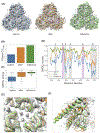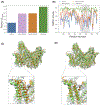Cryo-electron microscopy targets in CASP13: Overview and evaluation of results
- PMID: 31576602
- PMCID: PMC7197460
- DOI: 10.1002/prot.25817
Cryo-electron microscopy targets in CASP13: Overview and evaluation of results
Abstract
Structures of seven CASP13 targets were determined using cryo-electron microscopy (cryo-EM) technique with resolution between 3.0 and 4.0 Å. We provide an overview of the experimentally derived structures and describe results of the numerical evaluation of the submitted models. The evaluation is carried out by comparing coordinates of models to those of reference structures (CASP-style evaluation), as well as checking goodness-of-fit of modeled structures to the cryo-EM density maps. The performance of contributing research groups in the CASP-style evaluation is measured in terms of backbone accuracy, all-atom local geometry and similarity of inter-subunit interfaces. The results on the cryo-EM targets are compared with those on the whole set of eighty CASP13 targets. A posteriori refinement of the best models in their corresponding cryo-EM density maps resulted in structures that are very close to the reference structure, including some regions with better fit to the density.
Keywords: CASP; cryo-EM; electron microscopy; model evaluation; protein structure prediction.
© 2019 Wiley Periodicals, Inc.
Figures









References
-
- Lensink MF, Wodak SJ. CAPRI Evaluation in CASP13. Proteins 2019;This issue.
-
- Kryshtafovych A, Monastyrskyy B, Schwede T, Topf M, Moult J, Fidelis K. CASP evaluation measures. Proteins 2019;This issue.

